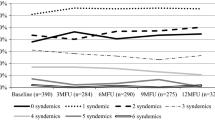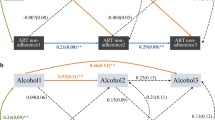Abstract
Improving adherence to antiretroviral therapy (ART) is essential for limiting HIV disease progression among young sexual minority men living with HIV. Daily diaries allow for a detailed examination of how fluctuations in psychosocial factors are associated with adherence over time. Across three cities in the United States, this study collected 60 days of quantitative data from 44 young men (between 16 and 24 years of age) living with HIV who have sex with men. Lagged transition models explored the associations of mood, stress, social support, substance use, and condomless intercourse with daily ART adherence. Baseline levels of illicit substance use and condomless intercourse, and a higher proportion of days with stress or marijuana use, were associated with lower ART adherence. Lapses in adherence predicted non-adherence the following day. Findings suggest prospective data collection may identify different predictors of adherence compared to retrospective recall. Lapse-management strategies are needed to improve adherence following a missed dose.

Similar content being viewed by others
Data Availability
Data are available through NICHD DASH via an approved data use agreement.
Code Availability
The SAS code to conduct the statistical analyses presented in this paper is available by request to the authors.
References
Ford N, Darder M, Spelman T, Maclean E, Mills E, Boulle A. Early adherence to antiretroviral medication as a predictor of long-term HIV virological suppression: Five-year follow up of an observational cohort. PLoS One. 2010;5(5):e10460. https://doi.org/10.1371/journal.pone.0010460.
Paterson DL, Swindells S, Mohr J, et al. Adherence to protease inhibitor therapy and outcomes in patients with HIV infection. Ann Intern Med. 2000;133(1):21. https://doi.org/10.7326/0003-4819-133-1-200007040-00004.
Centers for Disease Control and Prevention. HIV and Youth. Division of HIV/AIDS Prevention, National Center for HIV/AIDS, Viral Hepatitis, STD, and TB Prevention; 2020. https://www.cdc.gov/hiv/pdf/group/age/youth/cdc-hiv-youth.pdf
Beer L, Mattson CL, Bradley H, Shouse RL. Trends in ART prescription and viral suppression among HIV-positive young adults in care in the United States, 2009–2013. J Acquir Immune Defic Syndr. 2017;76(1):e1–6. https://doi.org/10.1097/QAI.0000000000001427.
Hosek SG, Harper GW, Domanico R. Predictors of medication adherence among HIV-infected youth. Psychol Health Med. 2005;10(2):166–79. https://doi.org/10.1080/1354350042000326584.
Murphy DA, Belzer M, Durako SJ, Sarr M, Wilson CM, Muenz LR. Longitudinal antiretroviral adherence among adolescents infected with Human Immunodeficiency Virus. Arch Pediatr Adolesc Med. 2005;159(8):764. https://doi.org/10.1001/archpedi.159.8.764.
Reisner SL, Mimiaga MJ, Skeer M, Perkovich B, Johnson CV, Safren SA. A review of HIV antiretroviral adherence and intervention studies among HIV-infected youth. Top HIV Med Publ Int AIDS Soc USA. 2009;17(1):14–25.
Williams PL, Storm D, Montepiedra G, et al. Predictors of adherence to antiretroviral medications in children and adolescents with HIV infection. Pediatrics. 2006;118(6):e1745–57. https://doi.org/10.1542/peds.2006-0493.
Halkitis PN, Kutnick AH, Slater S. The social realities of adherence to protease inhibitor regimens: Substance use, health care and psychological states. J Health Psychol. 2005;10(4):545–58. https://doi.org/10.1177/1359105305053422.
Harkness A, Bainter SA, O’Cleirigh C, Mendez NA, Mayer KH, Safren SA. Longitudinal effects of syndemics on ART non-adherence among sexual minority men. AIDS Behav. 2018;22(8):2564–74. https://doi.org/10.1007/s10461-018-2180-8.
White JM, Gordon JR, Mimiaga MJ. The role of substance use and mental health problems in medication adherence among HIV-infected MSM. LGBT Health. 2014;1(4):319–22. https://doi.org/10.1089/lgbt.2014.0020.
Bajos N. Social factors and the process of risk construction in HIV sexual transmission. AIDS Care. 1997;9(2):222–37.
Schroder KEE, Carey MP, Vanable PA. Methodological challenges in research on sexual risk behavior: II. Accuracy of self-reports. Ann Behav Med. 2003;26(2):104–23. https://doi.org/10.1207/S15324796ABM2602_03.
Bylsma LM, Rottenberg J. Uncovering the dynamics of emotion regulation and dysfunction in daily life with ecological momentary assessment. In: Nyklicek I, Vingerhoets A, Zeelenberg M, editors. Emotion Regulation and Well-Being. Springer; 2011. p. 225–44.
Shiffman S, Stone AA, Hufford MR. Ecological momentary assessment. Annu Rev Clin Psychol. 2008;4(1):1–32. https://doi.org/10.1146/annurev.clinpsy.3.022806.091415.
Cook PF, Schmiege SJ, Starr W, Carrington JM, Bradley-Springer L. Prospective state and trait predictors of daily medication adherence behavior in HIV. Nurs Res. 2017;66(4):275–85. https://doi.org/10.1097/NNR.0000000000000216.
Amico KR. Evidence for technology interventions to promote ART adherence in adult populations: A review of the literature 2012–2015. Curr HIV/AIDS Rep. 2015;12(4):441–50. https://doi.org/10.1007/s11904-015-0286-4.
Dowshen N, Kuhns LM, Johnson A, Holoyda BJ, Garofalo R. Improving adherence to antiretroviral therapy for youth living with HIV/AIDS: A pilot study using personalized, interactive, daily text message reminders. J Med Internet Res. 2012;14(2): e51. https://doi.org/10.2196/jmir.2015.
Mbuagbaw L, Sivaramalingam B, Navarro T, et al. Interventions for enhancing adherence to antiretroviral therapy (ART): A systematic review of high quality studies. AIDS Patient Care STDs. 2015;29(5):248–66. https://doi.org/10.1089/apc.2014.0308.
Thakkar J, Kurup R, Laba T-L, et al. Mobile telephone text messaging for medication adherence in chronic disease: A meta-analysis. JAMA Intern Med. 2016;176(3):340. https://doi.org/10.1001/jamainternmed.2015.7667.
Haberer JE, Sabin L, Amico KR, et al. Improving antiretroviral therapy adherence in resource-limited settings at scale: a discussion of interventions and recommendations. J Int AIDS Soc. 2017;20(1):21371. https://doi.org/10.7448/IAS.20.1.21371.
Finitsis DJ, Pellowski JA, Johnson BT. Text message intervention designs to promote adherence to antiretroviral therapy (ART): A meta-analysis of randomized controlled trials. PLoS One. 2014;9(2):e88166. https://doi.org/10.1371/journal.pone.0088166.
Haberer JE, Musiimenta A, Atukunda EC, et al. Short message service (SMS) reminders and real-time adherence monitoring improve antiretroviral therapy adherence in rural Uganda. AIDS. 2016;30(8):1295–9. https://doi.org/10.1097/QAD.0000000000001021.
Orrell C, Cohen K, Mauff K, Bangsberg DR, Maartens G, Wood R. A randomized controlled trial of real-time electronic adherence monitoring with text message dosing reminders in people starting first-line antiretroviral therapy. JAIDS J Acquir Immune Defic Syndr. 2015;70(5):495–502. https://doi.org/10.1097/QAI.0000000000000770.
Sabin LL, Bachman DeSilva M, Gill CJ, et al. Improving adherence to antiretroviral therapy with triggered real-time text message reminders: The China adherence through technology study. J Acquir Immune Defic Syndr. 2015;69(5):551–9. https://doi.org/10.1097/QAI.0000000000000651.
Cherenack EM, Wilson PA, Kreuzman AM, Price GN. The Adolescent Medicine Trials Network for HIV/AIDS Interventions. The feasibility and acceptability of using technology-based daily diaries with HIV-infected young men who have sex with men: A comparison of internet and voice modalities. AIDS Behav. 2016;20(8):1744–53. https://doi.org/10.1007/s10461-016-1302-4.
Terry PC, Lane AM, Lane HJ, Keohane L. Development and validation of a mood measure for adolescents. J Sports Sci. 1999;17(11):861–72. https://doi.org/10.1080/026404199365425.
Cohen S, Doyle WJ, Turner RB, Alper CM, Skoner DP. Emotional style and susceptibility to the common cold. Psychosom Med. 2003;65(4):652–7. https://doi.org/10.1097/01.PSY.0000077508.57784.DA.
Sherbourne CD, Stewart AL. The MOS social support survey. Soc Sci Med. 1991;32(6):705–14.
Dohrenwend BS, Krasnoff L, Askenasy AR, Dohrenwend BP. The Psychiatric Epidemiology Research Interview Life Events Scale (PERI). In: Handbook of Stress: Theoretical and Clinical Aspects. New York: Free Press; 1982. p. 332–63.
Bolger N, Davis A, Rafaeli E. Effects of daily stress on negative mood. Annu Rev Psychol. 1989;57(5):808–18.
WHO Assist Working Group. The alcohol, smoking and substance involvement screening test (ASSIST): Development, reliability and feasibility. Addiction. 2002;97(9):1183–94. https://doi.org/10.1046/j.1360-0443.2002.00185.x.
Fitzmaurice G, Laird NM, Ware JH. Applied Longitudinal Analysis. 2nd ed. Hoboken: Wiley; 2011.
Ibrahim JG, Chen M-H, Lipsitz SR, Herring AH. Missing-data methods for generalized linear models: A comparative review. J Am Stat Assoc. 2005;100(469):332–46. https://doi.org/10.1198/016214504000001844.
Cook PF, Schmiege SJ, Reeder B, Horton-Deutsch S, Lowe NK, Meek P. Temporal immediacy: A two-system theory of mind for understanding and changing health behaviors. Nurs Res. 2018;67(2):108–21. https://doi.org/10.1097/NNR.0000000000000265.
Cohen S, Janicki-Deverts D, Doyle WJ, et al. Chronic stress, glucocorticoid receptor resistance, inflammation, and disease risk. Proc Natl Acad Sci. 2012;109(16):5995–9. https://doi.org/10.1073/pnas.1118355109.
Dhabhar FS. Acute stress enhances while chronic stress suppresses skin immunity: The role of stress hormones and leukocyte trafficking. Ann N Y Acad Sci. 2006;917(1):876–93. https://doi.org/10.1111/j.1749-6632.2000.tb05454.x.
Hartley S, Simon N, Larabi A, et al. Effect of smoked cannabis on vigilance and accident risk using simulated driving in occasional and chronic users and the pharmacokinetic–pharmacodynamic relationship. Clin Chem. 2019;65(5):684–93. https://doi.org/10.1373/clinchem.2018.299727.
Kouri E, Pope GH, Yurgelun-Todd D, Grub S. Attributes of heavy vs. occasional marijuana smokers in a college population. Biol Psychiatry. 1995;38:475–81.
Hammersley R, Leon V. Patterns of cannabis use and positive and negative experiences of use amongst university students. Addict Res Theory. 2006;14(2):189–205. https://doi.org/10.1080/16066350500453309.
Blackstone K, Woods SP, Weber E, Grant I, Moore DJ, the HNRP Group. Memory-based strategies for antiretroviral medication management: An evaluation of clinical predictors, adherence behavior awareness, and effectiveness. AIDS Behav. 2013;17(1):74–85. https://doi.org/10.1007/s10461-012-0308-9.
Agapie E, Avrahami D, Marlow J. Staying the course: System-driven lapse management for supporting behavior change. In: Kaye J, editor. Proceedings of the 2016 CHI Conference on Human Factors in Computing Systems. New York: ACM; 2016. p. 1072–83.
Safren SA, O’Cleirigh C, Tan JY, et al. A randomized controlled trial of cognitive behavioral therapy for adherence and depression (CBT-AD) in HIV-infected individuals. Health Psychol. 2009;28(1):1–10. https://doi.org/10.1037/a0012715.
Acknowledgements
We acknowledge NICHD DASH for providing the data that was used for this research. We thank the Adolescent Medicine Trials Network for HIV/AIDS Interventions, ATN 112 protocol team HIV clinic sites, and all of the clinic staff involved in this study, including Dr. Craig Wilson, ATN Principal Investigator; Dr. Patrick A. Wilson, ATN 112 Protocol Chair; The Adolescent Medicine Trials Network for HIV /AIDS Interventions (ATN), with NIH support through NICHD (Kapogiannis, B and Lee, S), with supplemental funding from NIDA (Davenny, K) and NIMH (Allison, S): U01 HD 40533 and U01 HD 40474. We extend our sincerest gratitude to each participant for their effort and willingness to take part in this research.
Funding
This work was supported by the Adolescent Medicine Trials Network for HIV/AIDS Interventions (ATN) from the National Institutes of Health (U24HD089880) through the Eunice Kennedy Shriver National Institute of Child Health and Human Development (NICHD), National Institute on Minority Health and Health Disparities (NIMHD), National Institute of Mental Health (NIMH), and National Institute on Drug Abuse (NIDA). The content is solely the responsibility of the authors and does not necessarily represent the official views of the National Institutes of Health.
Author information
Authors and Affiliations
Contributions
EC contributed to study design with the support of the ATN 112 protocol team. Data preparation and analysis was performed by KE and MP. The first draft of the manuscript was written by EC and KE. All authors commented on previous versions of the manuscript. All authors read and approved the final manuscript.
Corresponding author
Ethics declarations
Conflict of interest
The authors have no relevant financial or non-financial interests to disclose.
Ethical Approval
Ethical approval for research involving human participants was obtained from Institutional Review Boards (IRBs) at all participating institutions, including Columbia University Medical Center, University of North Carolina at Chapel Hill, Children’s Hospital of Philadelphia, Children’s Hospital of Michigan, and the University of Colorado School of Medicine Children’s Hospital. A federal Certificate of Confidentiality was obtained. This study was performed in accordance the 1964 Declaration of Helsinki and its later amendments.
Consent to Participate
Informed consent was obtained from all individual participants included in the study.
Consent for Publication
Not applicable.
Additional information
Publisher's Note
Springer Nature remains neutral with regard to jurisdictional claims in published maps and institutional affiliations.
Rights and permissions
About this article
Cite this article
Cherenack, E.M., Enders, K., Rupp, B.M. et al. Daily Predictors of ART Adherence Among Young Men Living with HIV Who Have Sex with Men: A Longitudinal Daily Diary Study. AIDS Behav 26, 1727–1738 (2022). https://doi.org/10.1007/s10461-021-03523-2
Accepted:
Published:
Issue Date:
DOI: https://doi.org/10.1007/s10461-021-03523-2




